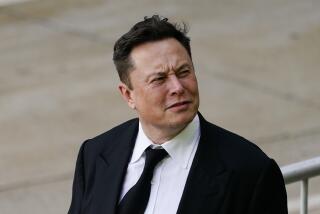Many Buying Choices Made Inside Store--So Guess Where the Ads Are
The last thing Procter & Gamble executives expect to see across from their headquarters is a billboard advertisement featuring Wisk. That, after all, is the dreaded competitor to their No. 1 seller, Liquid Tide.
But there the billboard sits--larger then any load of laundry.
And imagine trying to get Pepsi’s attention with an ad that says: “Hey Coke, bomb the fizz out of Pepsi.” Or rousing Nuprin’s interest with an ad that beckons: “Hey Advil, neutralize Nuprin.”
Behind all these billboards and trade magazine ads is an ad placement company--Actmedia Inc. of Westhampton Beach, N.Y.--that specializes in putting ads inside the nation’s supermarkets. The firm is trying to tweak the advertising giants, in hopes of getting more business. “We’re not trying to rub their noses in it,” said Bruce Failing, president of the company. “We just want their attention.”
It’s not that they don’t have the attention already--but they want lots more. Actmedia is responsible for placing most of the national brand advertisements that supermarket shoppers find dangling from their shopping carts, hanging on signs above aisles and sprouting from store shelves. The big advertisers like Procter & Gamble and General Mills spend $9 billion each year on this so-called point-of-purchase advertising.
Procter & Gamble is far and away the biggest user of Actmedia, which posted 1987 revenue of $100 million. Similarly, Ralston Purina, ranked as the nation’s 12th-largest advertiser, has spent millions of dollars promoting products such as Cat Chow and Wheat Chex inside supermarkets. “It’s a fairly new phenomenon,” said Patrick Farrell, a Ralston Purina spokesman.
The ad giants have only recently discovered that most people don’t bring shopping lists to the grocery store. In fact, a study by the Fort Lee, N.J.-based Point of Purchase Institute revealed that 81% of all buying decisions are made in the store, not in front of the television set.
“The fact is, Mr. Whipple is not on anyone’s mind when they walk into the grocery store,” Failing said. “They’re thinking about getting out of the store so they can get their kid to the dentist.”
So the object is to get the attention of shoppers when they’re in the store. And during the past six months, there’s been a sudden upsurge in grocery chain use of in-store advertising, said Steve Winston, senior executive editor at Progressive Grocer, a trade magazine. “But you haven’t seen anything yet.”
A few companies are trying to enter the market with video advertising in supermarkets, but none have yet caught on nationally.
The closest competitor to Actmedia is Superclocks, a subsidiary of Van Wagner Communications, which sells ad space on highly visible aluminum clocks it posts in 5,000 supermarkets nationally. Grocery chains, meanwhile, must wrestle with the decision of how much in-store advertising is too much. Not only does the rented ad space bring in extra income, but executives say that the ads can help sell products up to five times faster. “In the end,” said Joe Raymond, group vice president of sales at Vons Inc., “you have to decide how you want your stores to look.” Vons is still trying to decide how many ads shoppers will tolerate--and it just began testing the use of ads on store shelves in January.
But grocery stores aren’t the end--they’re a beginning. Actmedia has just signed contracts with three drugstore chains. And next? Said Failing: “Maybe hardware chains--or toy stores.”
Jaguar Tries Surrealism
It’s a jungle out there in the luxury car market. Just ask Jaguar Cars Inc., which, in a new ad campaign, is taking its redesigned sedan away from the posh country club setting and putting it into the backdrop of a surrealistic jungle. The $20-million campaign, created by New York-based Geer, DuBois Inc., is an attempt to lure new customers. U.S. sales of Jaguars--which sell for $44,000--were down 19% in the first quarter.
“There is a group of people out there who think Jaguar represents something they’re not interested in,” said Bob Burden, vice president of marketing. “We knew we had to do something drastic to convince them otherwise.”
New Minority Voice on Board
About a year ago, Los Angeles advertising executive J. Melvin Muse was attending a conference hosted by the Western States Advertising Agencies Assn. and noticed that he was the only black in the room. Muse, who is president of the recently formed shop Muse Cordero Chen & Baca, wrote a letter to the association. He informed them that he didn’t think the showing was representative of the California market.
You might say, he got action. Two weeks ago, Muse was elected the first minority member of the 40-year-old association’s 16-person board. Already, he has helped nudge the association into planning its first ethnic marketing workshop June 11, at the Beverly Hilton.
His company creates minority advertising for such companies as Pacific Bell and Southern California Gas Co. Muse’s 10-person shop speaks to clients in five languages. Said Muse: “Half the time I walk through our office and have no idea what’s being said.”
Florida Tax Angers Ad Biz
It was supposed to be a week of fun in the Orlando sun. But suddenly, Florida’s recently approved 5% state sales tax on services, including advertising, is hovering like a dark cloud over the American Advertising Federation’s annual conference scheduled in two weeks.
The group considered pulling out of Florida in protest--in line with a recent decision by NBC to yank its 1988 affiliates meeting out of Orlando. “But we decided we’d accomplish more by going and displaying our outrage than by staying away,” said Howard Bell, president of the association.
The group plans to begin organizing a statewide referendum that would bring the ad tax to a vote. And the theme of the conference has been changed from “the Magic of Creating Advertising,” to “Stop the Ad Tax.”
Competition Problems Brewing
The advertising agency that introduced Australian heartthrob Paul Hogan to the United States is about to find itself competing with him.
Mojo MDA, the ad firm that created Hogan’s well-known spots for the Australian Tourist Commission, has landed the $4-million U.S. account for Swan Premium Lager. Hogan, meanwhile, has been featured in a recent campaign for Foster’s Lager--one of Australia’s best-selling brews.
How to go up against Hogan? “It’ll be a tough row,” said Wayne Kingston, president of Mojo MDA’s U.S. operations. The agency has already signed an Australian television celebrity for Swan--but they’re not yet saying who.
Spuds--A Terrier on the Way Up
Look out, California Raisin Advisory Board. Spuds Mackenzie is on your tail. In its quarterly survey of 7,000 television viewers, New York-based Video Storyboard Tests Inc. reported that for the first three months of 1987, the famed dancing raisin spots are--for the second consecutive quarter--ranked by viewers as the “most outstanding” commercials.
But during the period, Spuds, the bull terrier in the Bud Light ads, has leaped into the No. 4 spot after placing 10th in the previous survey. “Spuds is especially appealing to the young people,” said Dave Vadehra, president of Video Storyboard. “He’s spunky.”
Anyway, It’s a Good Place to Meet
Newport Beach is hardly the raisin capital of California. But the ad firm that created the immensely popular “Dancing Raisins” commercial--Chicago-based Foote, Cone & Belding Communications Inc.--brought its annual meeting Monday to the balmy resort city anyway.
Why meet thousands of miles from the company’s headquarters? Explained a company spokesman: It’s a way of saying “good job” to the agency’s San Francisco office, which created the raisin ad for the California Raisin Advisory Board. So why not meet in San Francisco? Said the spokesman: “I haven’t the foggiest.”
More to Read
Inside the business of entertainment
The Wide Shot brings you news, analysis and insights on everything from streaming wars to production — and what it all means for the future.
You may occasionally receive promotional content from the Los Angeles Times.










